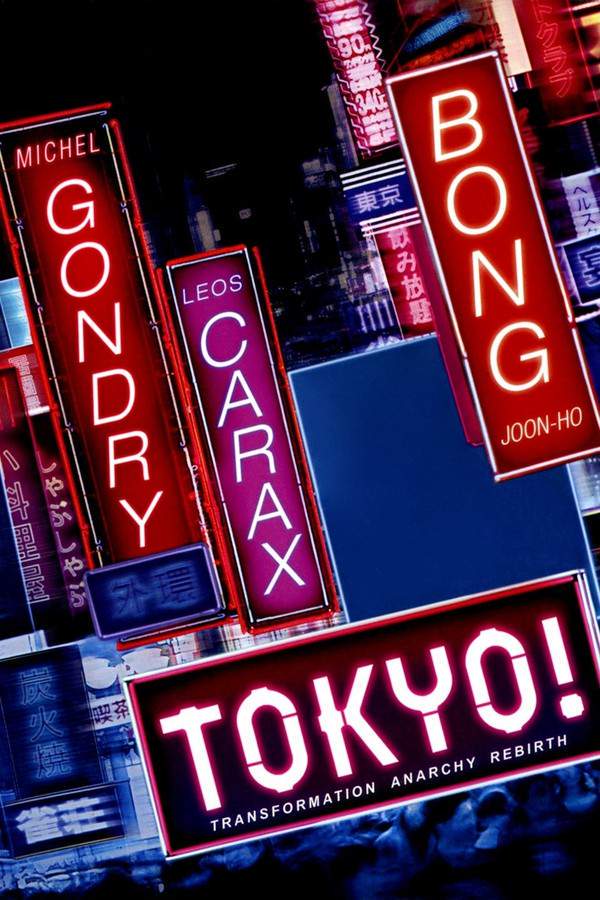Tokyo! 2009

This cinematic tribute to Tokyo presents a vibrant portrait of the city through the perspectives of three directors. The film interweaves various stories, revealing the everyday lives and unexpected moments of its diverse population. From ordinary routines to surreal encounters, the movie captures the intricate connections between people and the ever-changing landscape of this dynamic metropolis, showcasing its unique spirit and defying conventional expectations.
Does Tokyo! have end credit scenes?
No!
Tokyo! does not have end credit scenes. You can leave when the credits roll.
Meet the Full Cast and Actors of Tokyo!
Explore the complete cast of Tokyo!, including both lead and supporting actors. Learn who plays each character, discover their past roles and achievements, and find out what makes this ensemble cast stand out in the world of film and television.
No actors found
External Links and Streaming Options
Discover where to watch Tokyo! online, including streaming platforms, rental options, and official sources. Compare reviews, ratings, and in-depth movie information across sites like IMDb, TMDb, Wikipedia or Rotten Tomatoes.
Ratings and Reviews for Tokyo!
See how Tokyo! is rated across major platforms like IMDb, Metacritic, and TMDb. Compare audience scores and critic reviews to understand where Tokyo! stands among top-rated movies in its genre.

63
Metascore
6.6
User Score


76%
TOMATOMETER

71%
User Score
Take the Ultimate Tokyo! Movie Quiz
Challenge your knowledge of Tokyo! with this fun and interactive movie quiz. Test yourself on key plot points, iconic characters, hidden details, and memorable moments to see how well you really know the film.
Tokyo! Quiz: Test your knowledge on the intricacies of the film 'Tokyo!' and its unique narratives.
Who directed the segment featuring Hiroko and Akira?
Michel Gondry
Bong Joon-ho
Léos Carax
Denis Lavant
Show hint
Full Plot Summary and Ending Explained for Tokyo!
Read the complete plot summary of Tokyo!, including all major events, twists, and the full ending explained in detail. Explore key characters, themes, hidden meanings, and everything you need to understand the story from beginning to end.
Behind the lens of Michel Gondry, there’s a deep exploration of love and resilience in his adaptation of Gabrielle Bell’s poignant comic, Cecil and Jordan in New York. The narrative unfolds around Hiroko and Akira, a young couple from the provinces trying to survive in the bustling life of Tokyo, grappling with tight finances and unstable living conditions. Their bond appears rock-solid, a testament to their unwavering support for one another, but Akira, an aspiring filmmaker who wraps gifts at a department store, faces mounting pressure and frustration as he waits for his debut film to catch a break.
As they adapt to the challenges of temporary housing, they find solace in the cramped studio apartment of Hiroko’s friend, Akemi. But the couple’s luck runs out when Akemi’s boyfriend grows tired of their presence, pushing Hiroko to seek out new living arrangements. Unfortunately, her search is met with dishearteningly high rents and undesirable accommodations. Meanwhile, Akira’s film screening garners mixed reviews, and a particularly honest comment from an audience member resonates deeply with Hiroko, who learns that many creative souls often grapple with feelings of being invisible or undervalued.
As Hiroko confronts the stark realities of her life in the bustling city, doubts about her role in the relationship begin to swirl in her mind. One morning, she wakes to a shocking discovery: a small hole in her chest illuminated by sunlight. In horror, she realizes that the hole, now hand-sized, has a wooden pole running through it.
Days go by, and her transformation becomes increasingly alarming. The hole expands, leading to her feet becoming wooden poles, until she finds herself reduced to an inanimate chair, save for her jacket draped on the back. The world around her has become oblivious to her plight, except for one man who attempts to take her home, only for Hiroko to return to her human form and flee, naked, to a nearby bus station.
In an attempt to reclaim her humanity, Hiroko chooses to sit as a chair on the street. A compassionate musician rescues her, inviting her into his home where he shows her kindness. In the quiet of the apartment, she begins composing a farewell letter to Akira, wishing him the best as he chases his dreams in filmmaking.
This heartfelt film intricately weaves themes of identity, transformation, and the delicate threads of human relationships, as Gondry’s direction brings to life a touching narrative about seeking meaning in a world that often feels disorienting.
Meanwhile, in the unflinching vision of Léos Carax, Merde rises from the depths of the Tokyo sewers, portrayed by Denis Lavant. This grotesque figure wreaks havoc on the unsuspecting public, instilling terror with his audacious thefts and heinous acts, triggering an uproar across the city. In the wake of this chaos, French magistrate Maître Voland, played by Jean-François Balmer, arrives to defend Merde in a highly publicized trial that spirals into a spectacle of surreal confusion. Despite being convicted and sentenced to death, Merde manages to evade his executioners, slipping back into the shadows of the sewer.
Contrasting this horror, Bong Joon-ho’s Shaking Tokyo presents a haunting narrative through the eyes of Teruyuki Kagawa, a hikikimori who has isolated himself in his apartment for a decade. His only lifeline to the outside world is a telephone, which connects him to delivery services, leading to a mountain of pizza boxes piling up in his cramped living space. A turning point occurs when a new delivery girl, Yū Aoi, unknowingly enchants him with her warmth. When an earthquake hits and she faints in his presence, his previously stagnant world shifts, igniting a poignant infatuation. Eventually, he learns that she too shares his reclusive tendencies, prompting him to brave the outside world in search of her, only to be met with the tremors of another quake, shedding light on the vulnerability and fleeting nature of human connections.
Uncover the Details: Timeline, Characters, Themes, and Beyond!

Coming soon on iOS and Android
The Plot Explained Mobile App
From blockbusters to hidden gems — dive into movie stories anytime, anywhere. Save your favorites, discover plots faster, and never miss a twist again.
Sign up to be the first to know when we launch. Your email stays private — always.
Discover Film Music Concerts Near You – Live Orchestras Performing Iconic Movie Soundtracks
Immerse yourself in the magic of cinema with live orchestral performances of your favorite film scores. From sweeping Hollywood blockbusters and animated classics to epic fantasy soundtracks, our curated listings connect you to upcoming film music events worldwide.
Explore concert film screenings paired with full orchestra concerts, read detailed event information, and secure your tickets for unforgettable evenings celebrating legendary composers like John Williams, Hans Zimmer, and more.


Cars Featured in Tokyo!
Explore all cars featured in Tokyo!, including their makes, models, scenes they appear in, and their significance to the plot. A must-read for car enthusiasts and movie buffs alike.
Tokyo! Themes and Keywords
Discover the central themes, ideas, and keywords that define the movie’s story, tone, and message. Analyze the film’s deeper meanings, genre influences, and recurring concepts.
Tokyo! Other Names and Titles
Explore the various alternative titles, translations, and other names used for Tokyo! across different regions and languages. Understand how the film is marketed and recognized worldwide.
Similar Movies To Tokyo! You Should Know About
Browse a curated list of movies similar in genre, tone, characters, or story structure. Discover new titles like the one you're watching, perfect for fans of related plots, vibes, or cinematic styles.
Quick Links: Summary, Cast, Ratings, More

What's After the Movie?
Not sure whether to stay after the credits? Find out!
Explore Our Movie Platform
New Movie Releases (2025)
Famous Movie Actors
Top Film Production Studios
Movie Plot Summaries & Endings
Major Movie Awards & Winners
Best Concert Films & Music Documentaries
Movie Collections and Curated Lists
© 2025 What's After the Movie. All rights reserved.











































